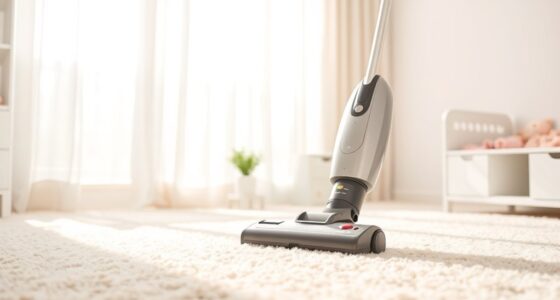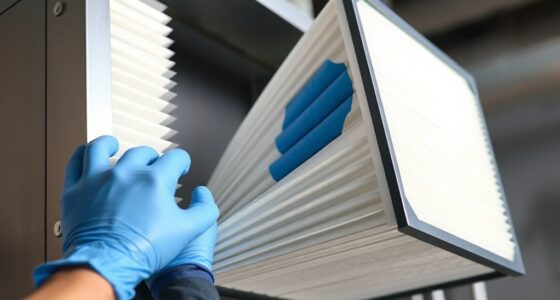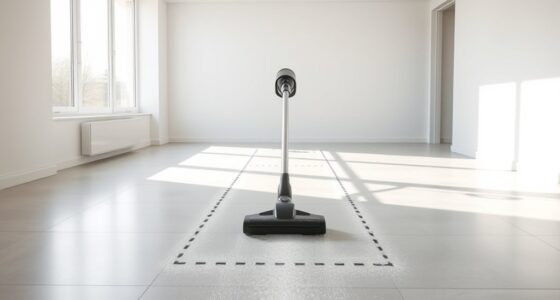During pollen season, upgrading your vacuum filters to high-efficiency options like HEPA can make a real difference by capturing tiny pollen particles and reducing indoor allergens. Make certain your vacuum is compatible with these filters and regularly maintain them for peak results. HEPA filters trap more irritants and improve air quality, helping lessen allergy symptoms. Want more tips on choosing and maintaining the best filter for your needs? Keep going to discover how to keep your home healthier during pollen season.
Key Takeaways
- Upgrade to HEPA filters to effectively trap tiny pollen particles and improve indoor air quality during pollen season.
- Ensure filter compatibility with your vacuum model to maintain optimal performance and allergen filtration.
- Regularly inspect and replace filters to prevent clogging and maintain strong suction and allergen removal.
- Consider electrostatic filters for enhanced pollen capture with minimal impact on vacuum noise and efficiency.
- Use filters with longer lifespan and proper maintenance routines to sustain effective pollen filtration throughout the season.
Understanding the Importance of Filtration During Pollen Season

During pollen season, proper filtration becomes essential because airborne pollen can easily enter your home and trigger allergies. Upgrading your vacuum filters enhances air purifier benefits by capturing tiny pollen particles, reducing indoor allergens. Effective filtration helps manage allergy symptoms by preventing pollen from settling on surfaces and circulating in the air. When your vacuum system efficiently traps allergens, you breathe in cleaner air, which can lessen sneezing, congestion, and itchy eyes. This is especially helpful if you or family members suffer from seasonal allergies. Investing in high-quality filters ensures that your home remains a healthier environment during peak pollen times. Regular filter maintenance and professional guidance can optimize your filtration system’s performance. Remember, good filtration isn’t just about cleaning surfaces; it’s about improving overall indoor air quality for better allergy symptom management.
Types of Vacuum Filters and Their Effectiveness Against Pollen
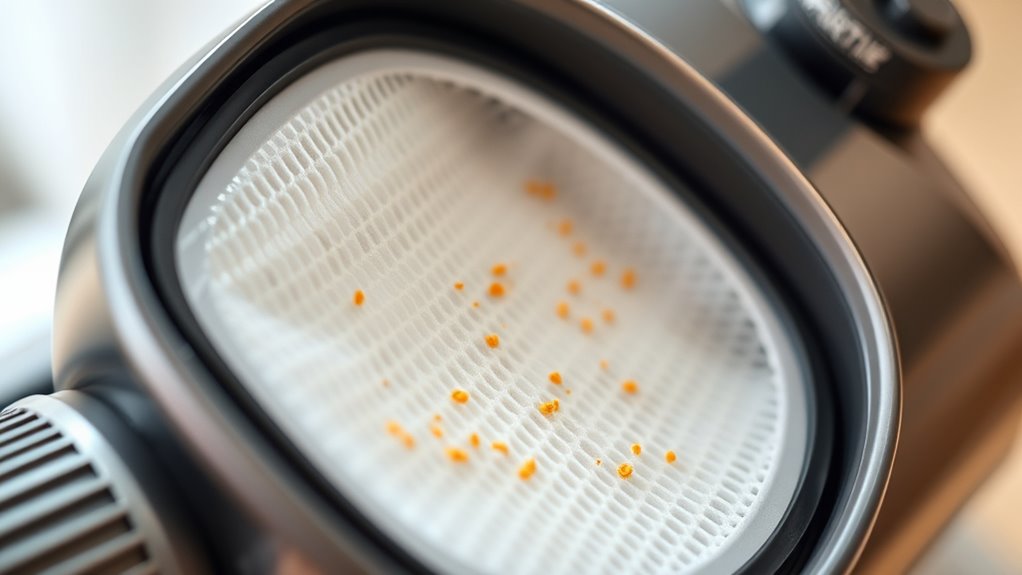
Choosing the right vacuum filter can substantially impact how well your home stays pollen-free. HEPA filters are top-tier for allergen filtration efficiency, capturing tiny pollen particles and preventing their circulation. When selecting filters, consider air purifier compatibility to ensure your vacuum works seamlessly with high-efficiency filters. Standard foam filters offer basic pollen trapping but fall short compared to HEPA or electrostatic filters. Electrostatic filters use charged fibers to attract pollen, boosting allergen removal. For maximum pollen control, upgrade to a HEPA filter compatible with your vacuum, as it provides superior allergen filtration efficiency. This upgrade not only improves indoor air quality but also reduces airborne pollen, helping you breathe easier during pollen season. Incorporating automation in business can also help streamline maintenance routines, ensuring filters are replaced or cleaned regularly for optimal performance.
Recognizing When to Upgrade Your Vacuum’s Filter System
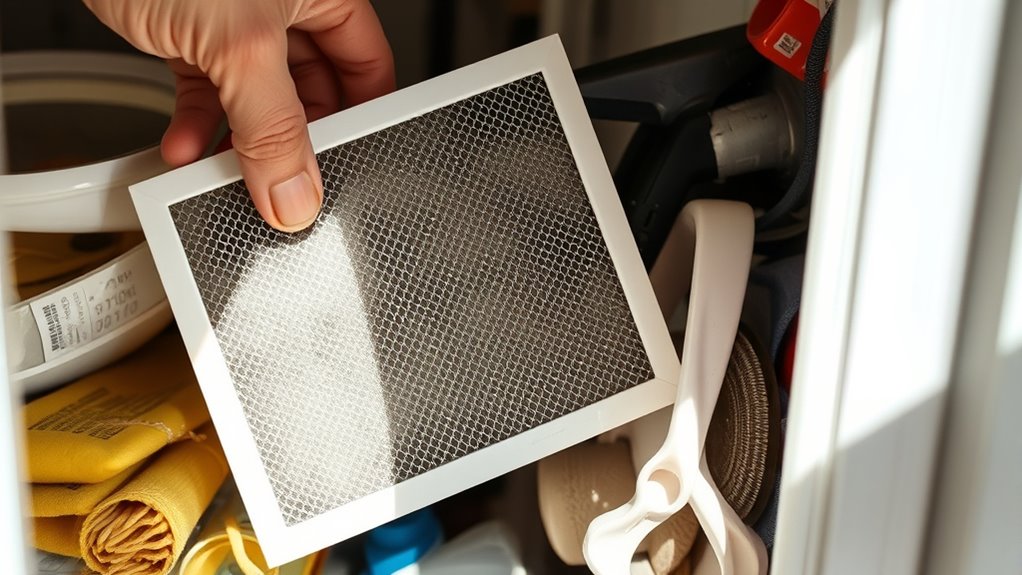
If your allergy symptoms worsen or you notice less suction, it might be time to upgrade your vacuum’s filter. Visible wear on the filter indicates it’s no longer effective, and a decrease in cleaning performance is a clear sign. Paying attention to these signs helps guarantee your vacuum continues to trap pollen and other allergens effectively.
Increased Allergic Symptoms
As allergy season ramps up, you might notice that your symptoms become more persistent or severe despite your usual cleaning routine. If you find yourself sneezing, coughing, or experiencing itchy eyes more often, it could be a sign your vacuum’s filter isn’t capturing enough pollen and dust. Poor dust trapping efficiency allows allergens to circulate back into the air, worsening your symptoms. Check if your vacuum’s filter system is compatible with air purifiers or allergen-specific filters, which can considerably reduce airborne particles. Upgrading to a high-efficiency filter helps trap more pollen and dust, improving indoor air quality. Recognizing these increased allergic symptoms is your cue to think about filter upgrades, ensuring your vacuum works more effectively against allergens and helps you breathe easier. Additionally, considering vacuum tuning options can optimize your appliance’s performance for allergen control.
Reduced Suction Power
Reduced suction power is a clear sign that your vacuum’s filter system may need an upgrade. When filters become clogged or less efficient, your vacuum struggles to pick up dust and pollen, leading to decreased performance. You might notice that your vacuum makes more vacuum noise than usual or that it’s less effective at cleaning. If you’re constantly battling reduced suction, it’s time to check the filter. A dirty or worn filter can also cause inconvenience during filter disposal, as it might release more dust or allergens back into the air. Upgrading your vacuum’s filter system ensures better airflow, maintains strong suction, and reduces the strain on your vacuum. Incorporating workspace organization techniques can help keep filters cleaner longer by making maintenance easier. This simple step helps keep your home cleaner and your allergy symptoms in check during pollen season.
Visible Filter Wear
A visible sign that your vacuum’s filter needs an upgrade is noticeable wear and tear. Over time, filter wear becomes evident through discoloration, frayed edges, or accumulated debris that no longer comes off easily. If the filter looks dirty or damaged, it’s a clear sign that its filter lifespan has been reached, reducing its effectiveness. Continuing to use a worn filter can compromise your vacuum’s cleaning power and allergen control. Regularly inspecting your filter allows you to identify when it’s time for a replacement or upgrade. Don’t wait until your vacuum’s performance drops considerably—addressing visible filter wear promptly ensures ideal filtration and maintains your vacuum’s efficiency during pollen season. Upgrading at the right time keeps your home cleaner and healthier, especially with proper filter maintenance and timely replacements.
Benefits of HEPA Filters for Allergy Relief
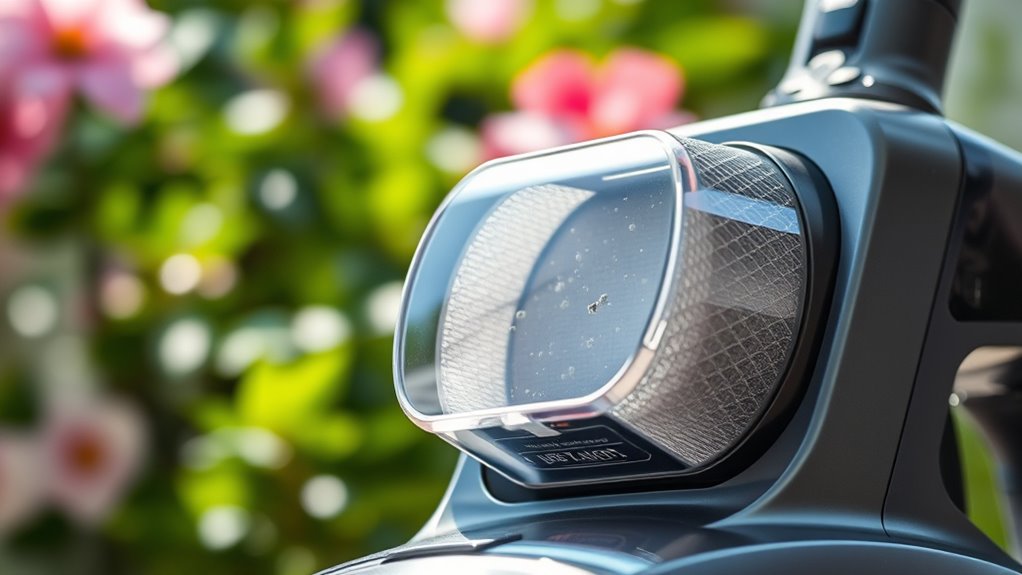
HEPA filters are highly effective at capturing tiny airborne particles, making them an essential upgrade during pollen season. By trapping pollen, dust mites, pet dander, and other allergens, they markedly improve your indoor air quality. This reduction in airborne irritants can lead to fewer allergy symptoms and easier breathing. Additionally, HEPA filters often have a longer filter lifespan, meaning they maintain their effectiveness over time when properly maintained. This durability ensures consistent allergen removal without frequent replacements, saving you money and effort. Regularly monitoring your filter’s condition can further enhance your indoor air quality and ensure optimal performance. Upgrading to a vacuum with a HEPA filter is a straightforward way to create a cleaner, healthier environment during pollen season, helping you breathe easier and reduce allergy flare-ups.
Step-by-Step Guide to Replacing or Upgrading Your Vacuum Filter
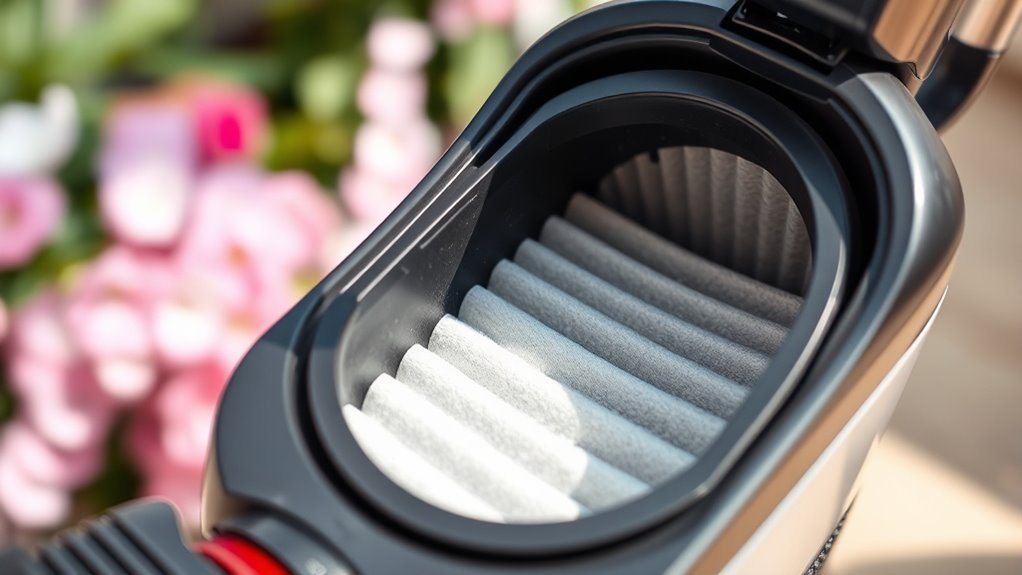
Replacing or upgrading your vacuum filter is simple when you know the steps. First, you’ll need to select the right filter for your model and needs. Once you have it, you’ll learn how to install it properly and keep it maintained for ideal performance. Using the appropriate essential oils can also help maintain a fresh and clean environment during your cleaning routine.
Selecting the Right Filter
Choosing the right vacuum filter is essential for effectively capturing pollen and allergens during peak season. To guarantee optimal performance, focus on filter compatibility with your vacuum model and consider options for filter customization. The right fit maximizes efficiency and reduces allergy triggers.
Here’s a quick guide:
| Compatibility Check | Customization Options | Confidence Level |
|---|---|---|
| Is it designed for your vacuum? | Can you adjust or replace parts? | Are reviews positive? |
| Ensures pollen stays trapped | Tailors filtration to your needs | Matches your allergy severity? |
| Avoids damage or inefficiency | Allows upgrades for better filtering | Feel assured in your choice? |
Selecting the right filter keeps your home healthier and your vacuum running smoothly.
Installation and Maintenance
Upgrading or replacing your vacuum filter is a straightforward process that guarantees ideal allergen removal during pollen season. First, verify you have the right filter that matches your vacuum’s compatibility to avoid damage or reduced efficiency. Turn off and unplug your vacuum before opening the filter compartment. Remove the existing filter carefully and check its condition; if it’s dirty or damaged, replace it. Install the new filter securely, making sure it fits snugly for maximum filter longevity. Regular maintenance involves cleaning reusable filters as recommended by the manufacturer and replacing disposable ones when they’re dirty or at the end of their lifespan. Proper installation and routine upkeep help maintain vacuum performance, ensuring your filter continues to effectively trap pollen and allergens throughout the season. Additionally, consulting the manufacturer’s guidelines for specific filter maintenance can extend the lifespan and efficiency of your vacuum’s filtration system.
Additional Tips for Maintaining Better Indoor Air Quality

To maintain better indoor air quality during pollen season, it is essential to keep your living space clean and well-ventilated. Consider exploring air purifier options that suit your needs, especially those with HEPA filters designed to capture pollen and allergens effectively. Regularly changing or cleaning filters guarantees maximum performance. Additionally, indoor humidity control plays a critical role; aim to keep humidity levels between 30-50%. Too high humidity can encourage mold and dust mites, while too low can cause dryness and irritation. Use a dehumidifier or humidifier as needed to maintain balance. Proper ventilation, combined with these strategies, helps reduce airborne allergens and keeps your indoor environment healthier during pollen season. Choosing a device with auto functionality can automatically adjust filtration based on air quality, further improving indoor air standards.
Choosing the Right Vacuum Filter for Your Household Needs
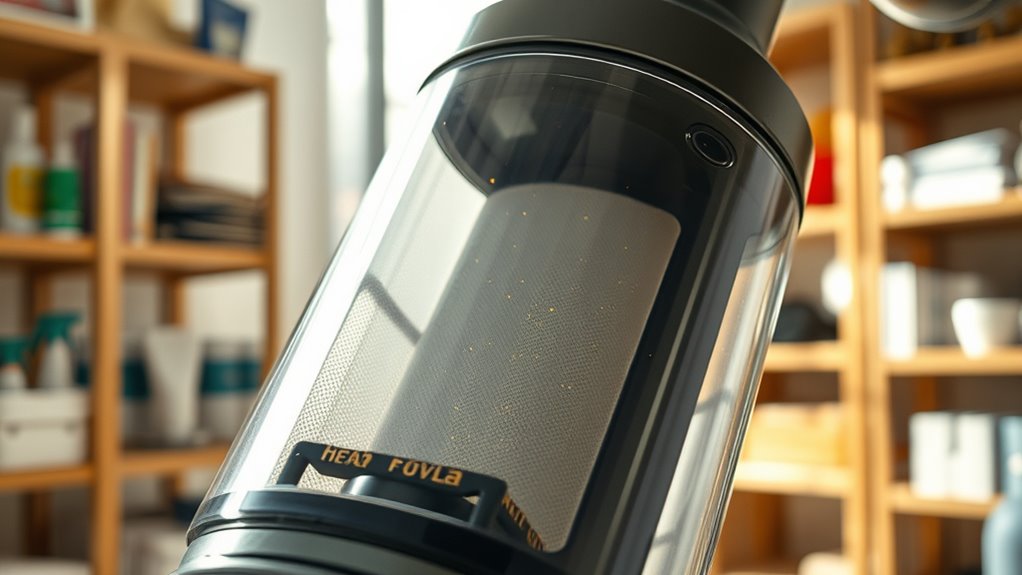
Selecting the right vacuum filter can considerably improve your home’s air quality, especially during pollen season. To choose the best filter for your needs, consider these factors:
Choosing the right vacuum filter enhances air quality, especially during pollen season.
- Filter Efficiency: Look for HEPA filters that trap small particles like pollen and allergens.
- Vacuum Noise: Some filters may reduce noise, making vacuuming less disruptive.
- Filter Cost: Balance your budget with filter durability and replacement expenses.
- Compatibility: Confirm the filter fits your vacuum model for maximum performance.
- Additionally, opting for filters designed to enhance air filtration efficiency can provide further relief during allergy-prone seasons.
Frequently Asked Questions
How Often Should I Replace My Vacuum Filter During Pollen Season?
During pollen season, you should replace your vacuum filter every 1 to 3 months, depending on the vacuum filter lifespan and how often you vacuum. This guarantees allergy-friendly vacuum features stay effective and maintain ideal air quality. Regular filter changes prevent buildup of allergens, helping you breathe easier. Check your vacuum’s manual for specific recommendations, and consider upgrading to filters designed for allergy relief to maximize your vacuum’s performance during peak pollen times.
Can a Regular Vacuum Filter Effectively Trap Pollen Particles?
Did you know that HEPA filters can trap 99.97% of particles as small as 0.3 microns? A regular vacuum filter may not effectively trap pollen particles, especially if it lacks allergen capture features. HEPA filters are specially designed for allergen capture, making them much better for pollen season. If you want cleaner air, upgrading to a HEPA filter guarantees pollen and other allergens are efficiently removed from your home.
Are There Specific Vacuum Models Better Suited for Pollen Allergies?
When choosing a vacuum model for pollen allergies, you want one with allergy-friendly designs that effectively trap fine particles. Look for models with HEPA filters and sealed systems, which prevent pollen from escaping back into the air. These features guarantee better allergen removal and improve air quality. Picking the right vacuum model selection helps you manage pollen season more comfortably and reduces allergy symptoms indoors.
How Do I Know if My Current Filter Is Insufficient for Pollen Removal?
You can tell if your current filter is insufficient for pollen removal by observing its filter performance. If you notice persistent allergy symptoms despite regular vacuuming, your filter might not trap enough pollen. Check if your filter is HEPA-rated, as these are designed to capture tiny particles like pollen. Upgrading to a higher-quality filter can markedly reduce pollen in your home and help ease allergy symptoms.
Do Costlier Filters Always Provide Better Pollen Filtration?
Think of filters like armor—more expensive ones don’t always mean better protection. While costlier filters often use advanced filter materials, they don’t guarantee improved pollen filtration. It’s vital to take into account filter lifespan and whether the material captures tiny particles effectively. Cheaper filters may be sufficient if they’re high-quality, but investing in a filter designed specifically for pollen can ensure better air quality without overspending.
Conclusion
Upgrading your vacuum filter before pollen season can notably improve indoor air quality and reduce allergy symptoms. Did you know that HEPA filters can trap up to 99.97% of airborne particles, including pollen? By choosing the right filter and maintaining it properly, you create a healthier environment for your family. Don’t wait—investing in a high-quality filter now can make your allergy season much easier and more comfortable.



